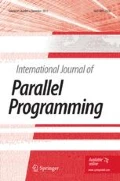Abstract
This paper introduces a method for runtime identification of sets of interacting activities (“working sets”) with the purpose ofcoscheduling them, i.e., scheduling them so that all the activities in the set execute simultaneously on distinct processors. The identification is done by monitoring access rates to shared communication objects: activities that access the same objects at a high rate thereby interact frequently, and therefore would benefit from coscheduling. Simulation results show that coscheduling with our runtime identification scheme can give better performance than uncoordinated scheduling based on a single global activity queue. The finer-grained the interactions among the activities in a working set, the better the performance differential. Moreover, coscheduling based on automatic runtime identification achieves about the same performance as coscheduling based on manual identification of working sets by the programmer.
Similar content being viewed by others
References
J. K. Ousterhout, Scheduling Techniques for Concurrent Systems,3rd Intl. Conf. Distributed Computing Syst., pp. 22–30 (1982).
J. Edler, A. Gottlieb, C. P. Kruskal, K. P. McAuliffe, L. Rudolph, M. Snir, P. J. Teller, and J. Wilson, Issues Related to MIMD Shared-Memory Computers: The NYU Ultracomputer Approach,12th Ann. Intl. Symp. Computer Architecture Conf. Proc., pp. 126–135 (1985).
S. F. Hummel and E. Schonberg, Low-Overhead Scheduling of Nested Parallelism,IBM J. Research & Development,35(5/6):743–765 (1991).
S. Krakowiak,Principles of Operating Systems, MIT Press (1988).
D. G. Feitelson and L. Rudolph, Distributed Hierarchical Control for Parallel Processing,Computer,23(5):65–77 (1990).
INMOS Ltd.,Occam Programming Manual, Prentice-Hall (1984).
N. Francez, B. Hailpern, and G. Taubenfeld, Script: A Communication Abstraction Mechanism,Science of Computer Programing,6(1):35–88 (1986).
D. G. Feitelson, Communicators: Object-Based Multiparty Interactions for Parallel Programming, Technical Report 91-12, Department of Computer Science, The Hebrew University of Jerusalem (1991).
M. K. Seager and J. M. Stichnoth, Simulating the Scheduling of Parallel Supercomputer Applications, Technical Report UCRL-102059, Lawrence Livermore National Laboratory (1989).
B. C. Gorda and E. D. Brooks III, Gang Scheduling a Parallel Machine, Technical Report UCRL-JC-107020, Lawrence Livermore National Laboratory (1991).
P. Steiner, Extending Multiprogramming to a DMPP,Future Generation Comput. Syst.,8(1–3):93–109 (1992).
R. H. Campbell, N. Islam, and P. Madany, Choices, Frameworks and Refinement,Computing Systems,5(5):217–257 (1992).
D. G. Feitelson and L. Rudolph, Gang Scheduling Performance Benefits for Fine-Grain Synchronization,J. Parallel & Distributed Comput. 16(4):306–318 (1992).
E. M. Chaves Filho and V. C. Barbosa, Time Sharing in Hypercube Multiprocessors,4th IEEE Symp. Parallel & Distributed Processing, pp. 354–359 (1992).
J. A. Test, Multi-Processor Management in the Concentrix Operating System,Proc. Winter USENIX Technical Conf., pp. 173–182 (1986).
C. E. Leiserson, Z. S. Abuhamdeh, D. C. Douglas, C. R. Feynman, M. N. Ganmukhi, J. V. Hill, W. D. Hillis, B. C. Kuszmaul, M. A. St. Pierre, D. S. Wells, M. C. Wong, S.-W. Yang, and R. Zak, The Network Architecture of the Connection Machine CM-5,4th Symp. Parallel Algorithms & Architectures, pp. 272–285 (1992).
D. G. Feitelson, A Survey of Scheduling in Multiprogrammed Parallel Systems, Research Report RC 19790 (87657), IBM T. J. Watson Research Center (1994).
J. Błażewicz, M. Drabowski, and J. Węglarz, Scheduling Multiprocessor Tasks to Minimize Schedule Length,IEEE Trans. Computers,C-35(5):389–393 (1986).
D. G. Feitelson and L. Rudolph, Mapping and Scheduling in a Shared Parallel Environment Using Distributed Hierarchical Control,Intl. Conf. Parallel Processing, Vol. I, pp. 1–8 (1990).
D. G. Feitelson and L. Rudolph, Wasted Resources in Gang Scheduling,5th Jerusalem Conf. Information Technology, IEEE Computer Society Press, pp. 127–136 (1990).
H. Sullivan, T. R. Bashkow, and D. Klappholz, A Large Scale, Homogeneous, Fully Distributed Parallel Machine, II,4th Ann. Intl. Symp. Computer Architecture Conf. Proc., pp. 118–124 (1977).
A. M. van Tilborg and L. D. Wittie, Wave Scheduling—Decentralized Scheduling of Task Forces in Multicomputers,IEEE Trans. Computers,C-33(9):835–844 (1984).
D. L. Tuomenoksa and H. J. Siegel, Task Scheduling on the PASM Parallel Processing System,IEEE Trans. Software Engineering,SE-11(2):145–157 (1985).
A. Tucker and A. Gupta, Process Control and Scheduling Issues for Multiprogrammed Shared-Memory Multiprocessors,12th Symp. Operating Systems Principles, pp. 159–166 (1989).
C. McCann, R. Vaswani, and J. Zahorjan, A Dynamic Processor Allocation Policy for Multiprogrammed Shared-Memory Multiprocessors,ACM Trans. Computer Systems,11(2):146–178 (1993).
V. K. Naik, S. K. Setia, and M. S. Squillante, Scheduling of Large Scientific Applications on Distributed Memory Multiprocessor Systems,6th SIAM Conf. Parallel Processing for Scientific Computing, Vol. II, pp. 913–922 (1993).
C. McCann and J. Zahorjan, Processor Allocation Policies for Message Passing Parallel Computers,SIGMETRICS Conf. Measurement & Modeling of Comput. Syst., pp. 19–32 (1994).
S. T. Leutenegger and M. K. Vernon, The Performance of Multiprogrammed Multiprocessor Scheduling Policies,SIGMETRICS Conf. Measurement & Modeling of Comput. Syst., pp. 226–236 (1990).
A. Gupta, A. Tucker, and S. Urushibara, The Impact of Operating System Scheduling Policies and Synchronization Methods on the Performance of Parallel Applications,SIGMETRICS Conf. Measurement & Modeling of Comput. Syst., pp. 120–132 (1991).
J. Zahorjan, E. D. Lazowska, and D. L. Eager, The Effect of Scheduling Discipline on Spin Overhead in Shared Memory Parallel Systems,IEEE Trans. Parallel & Distributed Syst.,2(2):180–198 (1991).
D. L. Black, Scheduling Support for Concurrency and Parallelism in the Mach Operating System,Computer,23(5):35–43 (1990).
D. Ghosal, G. Serazzi, and S. K. Tripathi, The Processor Working Set and Its Use in Scheduling Multiprocessor Systems,IEEE Trans. Software Engineering,17(5):443–453 (1991).
Message Passing Interface Forum,MPI: A Message-Passing Interface Standard (1994).
E. G. Coffman, Jr., M. R. Garey, and D. S. Johnson, Approximation Algorithms for Bin-Packing—An Updated Survey,Algorithm Design for Computer Systems Design, G. Ausiello, M. Lucertini, and P. Serafini (eds.), Springer-Verlag, pp. 49–106 (1984).
A. R. Karlin, K. Li, M. S. Manasse, and S. Owicki, Empirical Studies of Competitive Spinning for a Shared-Memory Multiprocessor,13th Symp. Operating Systems Principles, pp. 41–55 (1991).
Author information
Authors and Affiliations
Rights and permissions
About this article
Cite this article
Feitelson, D.G., Rudolph, L. Coscheduling based on runtime identification of activity working sets. Int J Parallel Prog 23, 135–160 (1995). https://doi.org/10.1007/BF02577787
Received:
Revised:
Issue Date:
DOI: https://doi.org/10.1007/BF02577787




